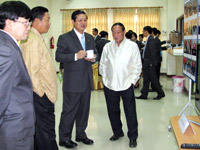Coffee tops Lao agricultural exports
Coffee tops Lao agricultural exports
Coffee is Laos' top income earner among all exports of agricultural products, earning about US$60 million last year.
Most of the crop is exported in the form of dried coffee to Taiwan, Italy, Japan, Spain, Poland, Germany, the US, France, Belgium, Sweden, Thailand and Vietnam, according to the agriculture sector.
A total of 18,300 tonnes of coffee was exported last year, with the volume expected to increase this year.
Maize is the crop pulling in the second highest income, at US$55 million last year, followed by rice (including paddy and polished rice) at about US$10 million, and cassava, which earned about US$40,000 last year.
Most of these products were exported to Vietnam, Thailand and China.
The revenue earned from these exports is making a valuable contribution to socio-economic development as well as improving the living conditions of local farming families.
Most coffee growers live in the southern provinces of Champassak, Saravan, Xekong and Attapeu. Maize is grown mostly in the north in Xayaboury, Oudomxay, Xieng Khuang and Luang Namtha provinces, while cassava is mainly grown in Vientiane and in Borikhamxay, Kha mmuan and Vientiane provinces.
Laos also exports tea, bananas, Job's tear, soybeans, sesame, sugar and cardamom. Average annual exports of agricultural and non-timber products, including coffee, maize, rice and cassava, are worth about US$218 million.
Laos is also processing more of these crops for export, but the figures for these products fall within the industry and commerce sector.
These crops will be the main products Laos will use to compete in regional and international markets when the Asean Economic Community comes into effect in 2015.
To develop these products to international standards, the agriculture and forestry sector is working with the industry and commerce sector to improve product quality and bolster organic farming. Officials are looking to these two areas to build a competitive edge in regional markets, as Laos cannot compete in terms of quantity.
The government is also improving phytosanitary measures to match international standards in line with World Trade Organisation requirements.
Agriculture and forestry products have proved to be significant income earners for the development process. Cultivation of these products is also well suited to the improvement of rural living standards, as most people make a living from the crops they grow and the livestock they raise, whether for their own consumption or for market sale
vientiane times















